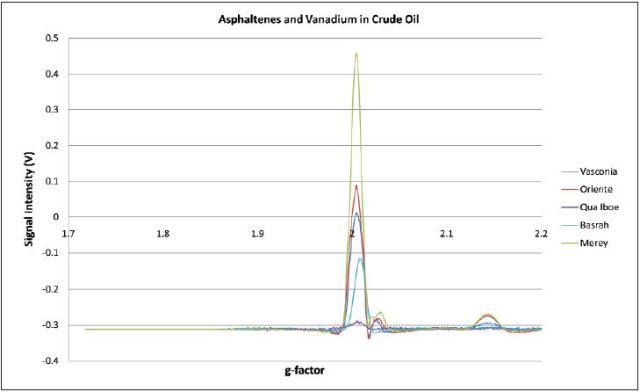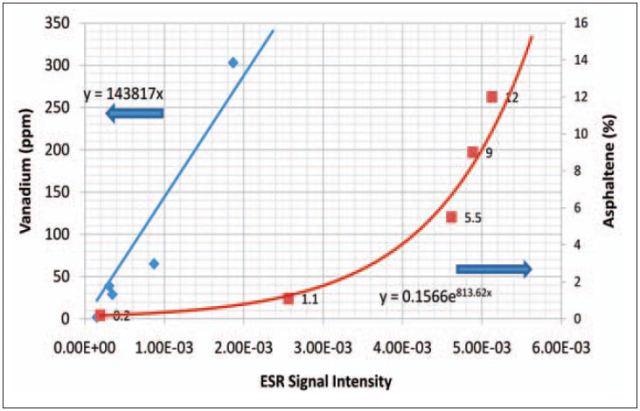Asphaltenes are a threat for crude oil producers and pipelines by increasing viscosity of the crude and potentially fouling pipelines and production equipment. Presently there are very few technologies for online monitoring of asphaltene concentration in crude oil. A new advancement is a microwave sensor technology that enables continuous online measurement of asphaltene and vanadium concentration in crude oil. This is based on electron spin resonance (ESR), a field of magnetic resonance spectrometry that determines the concentration and composition of molecules with unpaired electrons.
A characteristic spectrum attributed to asphaltenes and vanadyl porphyrins is shown by the ESR spectra of crude oil. Asphaltenes produce an intense organic free radical ESR signal at g = 2.0032 and vanadyl porphyrins produce an ESR spectrum with several broadly spaced, narrow peaks, a subset of which is measured by Micro-ESR.
The asphaltene concentration within 0.05% is determined by accurate measurement of the ESR spectrum of an unknown crude oil, along with simultaneous measurements of the microwave dielectric loss tangent and dielectric permittivity of the crude oil, and vanadium concentrations as low as 5 ppm. A key benefit of this technique is that it has extremely low sensitivity to so-called "cross-factors."
ESR
The composition and concentration of molecules with unpaired electrons is determined by an ESR spectrometer. The most common examples are free radicals and transition metal ions. Loading of the sample is done into a high frequency resonant cavity in a slowly varying uniform magnetic field. Unpaired electrons irradiated with microwave radiation at a fixed frequency undergo resonant transitions between the spin "up" and spin "down" state at a characteristic magnetic field governed by the equation hν = gβH.
Here, h is Planck's constant, β is the Bohr Magneton, ν is the resonant frequency, H is the applied magnetic field, and g is a characteristic of the radical (the "g-factor," an empirically determined number, often close to 2.0032). The magnetic field at resonance is a function of the g-factor, and the height of the resonant peak is determined by the concentration of the radical in the sample.

Figure 1. The area of the ESR peaks is not a simple linear function of vanadium and asphaltene concentrations in the sample. The central peak is a combination of the vanadium and asphaltene signal while the peripheral peaks are vanadium alone. Curve fitting must be used to identify the contribution of each component to the central peak. (Images courtesy of Bruker Biospin Inc.)
In this ESR, the sample is present in a high-Q ceramic resonant cavity, which has a large "fill factor" relative to a conventional ESR. Enhanced sensitivity is achieved but the size of the entire device is reduced by a factor of 1,000. The receiver and the microwave bridge now use modern low-cost components similar to those used in wireless communications devices. This has enabled dramatic cost reductions compared to conventional ESR spectrometers.
Experimental Results
Bruker Biospin performed direct ESR measurements of five crude oil samples with a measurement time of approximately 45 seconds per sample. Vanadium was measured by inductively coupled plasma, and asphaltenes were measured by precipitation in n-heptane for comparison , then weighed. It should be noted that the assay data for these samples was 10 to 15 years old therefore some variation between test results and the assay data could be expected.
Table 1. Direct ESR measurements of five crude oil samples
| SOURCE |
VANADIUM (PPM) |
ASPHALTENE (%) |
| Qua Iboe |
2 |
0.2 |
| Basrah Light |
29 |
1.1 |
| Vasconia |
39 |
5.5 |
| Merey |
303 |
9.0 |
| Oriente |
65 |
12.0 |
Figure 1 shows that the area of the ESR peaks is not a simple linear function of the vanadium and asphaltene concentrations in the sample. Also, the central peak is a combination of the vanadium and asphaltene signal, while the peripheral peaks are vanadium alone. It is possible to use curve fitting to identify the contribution of each component to the central peak.
Another factor to be considered is the variation in dielectric loss tangent between different oils. Micro-ESR automatically measures the microwave power and cavity loaded "Q." It is possible to compute correction factors for each type of oil. From this raw data can be normalized relative to a reference oil. In this case Qua Iboe, which has almost no asphaltene or vanadium content was used. After the data is normalized, Micro-ESR can accurately compute the asphaltene and vanadium concentrations by analyzing the area under each curve. The correlations between ESR measured data and assay data are shown in Figure 2.

Figure 2. Micro-ESR can accurately compute asphaltene and vanadium concentrations by analyzing the area under each curve.
Additional Applications
It is possible to determine both asphaltenes and vanadium precisely and correctly by ESR. However, latest advancements in low-cost high frequency microwave electronics, combined with modern computer-aided design techniques have enabled Bruker Biospin to build a highly miniaturized, rugged, and relatively low-cost instrument with very powerful online (or offline) measurement capabilities. This development marks a basic shift in the cost-benefit equation for electron spin resonance spectrometry, paving the way for a broad variety of applications in the petroleum industry, for example, monitoring asphaltene production in workover wells, asphaltene precipitation in pipeline operations, field assays of crude oil and oil-bearing sand and shale, and downstream applications in refining.

This information has been sourced, reviewed and adapted from materials provided by Bruker BioSpin - NMR, EPR and Imaging.
For more information on this source, please visit Bruker BioSpin - NMR, EPR and Imaging.